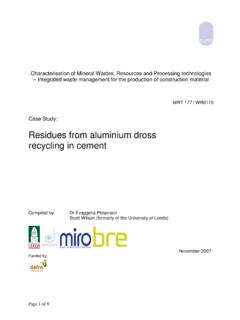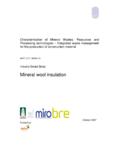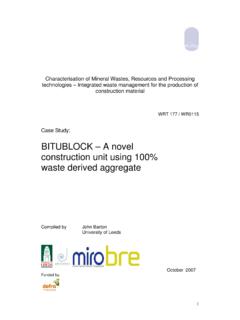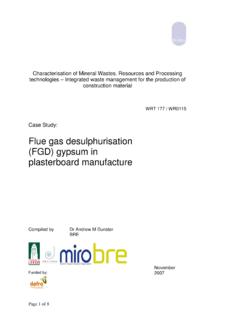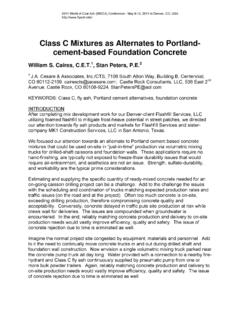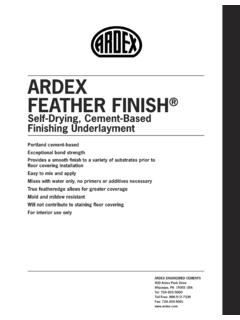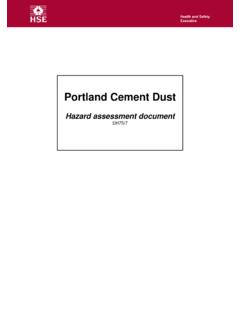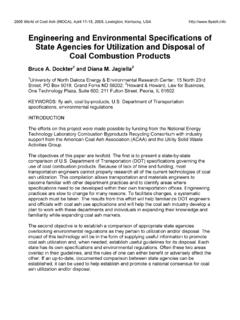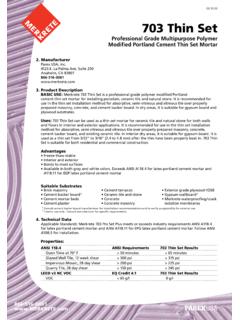Transcription of Portland cement paper sludge - SMARTWaste
1 Page 1 of 8 Characterisation of Mineral Wastes, Resources and Processing technologies Integrated waste management for the production of construction material WRT 177 / WR0115 Case Study: paper sludge and paper sludge ash in Portland cement manufacture Compiled by Dr Andrew M Dunster BRE Funded by: October 2007 Page 2 of 8 Introduction This case study describes the potential use of mill paper sludge and its derivatives, as ingredients in Portland cement manufacture. The study includes the use of the fly ash from combined heat & power (CHP) combustion of paper sludge (as a cement clinker input material) and the sludge itself (as an alternative liquid fuel). Further details of the role of alternative raw materials (ARM) and fuels in cement manufacture are given in the MINRES project cement sector study (1). paper sludge paper mill sludge is a major economic and environmental problem for the paper and board industry.
2 The material is a by-product of the de-inking and re-pulping of paper . The total quantity of paper mill sludge produced in the UK annually is approximately 1 million tonnes (2). The main recycling and disposal routes for paper sludge are land-spreading as agricultural fertiliser, incineration in CHP plants at the paper mill, producing paper sludge ash, or disposal to landfill. The scope for landfill spreading is limited and is covered by an industry code of practice (3,4). In functional terms, paper sludge consists of cellulose fibres, fillers such as calcium carbonate and china clay and residual chemicals bound up with water. The moisture content is typically up to 40%. The material is viscous, sticky and hard to dry and can vary in viscosity and lumpiness (2). It has an energy content that makes it a useful candidate as an alternative fuel for the manufacture of Portland cement . paper sludge is currently in use as an alternative fuel. It is classified as Class 2 (liquid alternative fuels) in the Cembureau classification of alternative fuels (5).
3 paper sludge ash After incinerating paper sludge at approximately 800 C, the resultant fly ash may contain reactive silica and alumina (in the form of metakaolin) as well as lime (CaO) which contribute chemically to the Portland cement ingredients. paper sludge ash is therefore potentially suitable as an ingredient in: - the cement kiln feed, contributing calcium, silica and alumina - the manufacture of blended cements The main producers of paper sludge ash currently in the UK are: - UPM - Shotton paper mill - Deeside North East Wales (6) - Aylesford Newsprint, Kent (7) UPM produce an ash material derived from paper sludge and biofuels (consisting mainly of chips from saw mills from their own sustainable forests). Aylesford Newsprint generate steam for their processes from a CHP plant. Some 86% of the sludge that they generate in production is combusted. Applications for the ash being pursued include use as a cement replacement (pozzolana), in block making production and synthetic aggregate pellets (trials) (6).
4 At the time of writing, UPM had been in discussion with the cement sector. It is known that Lafarge cement have trialled paper sludge ash material in the production of clinker feedstock for manufacturing Portland cement . Page 3 of 8 There is a high potential for the utilisation of paper sludge ash in construction and remediation as: - High volumes of paper ash are currently available in the UK due to the new CHP plant at Shotton paper mill, which incinerates all paper sludge , and the plant at Aylesford Newsprint. Shotton produces approximately 60,000 tonnes of ash per annum. It is likely that the current UK production of ash exceeds 100,000 tonnes per annum. - paper ash is a suitable material for the production of blended cement , but is also suitable for land-spreading (current use) and waste neutralisation. - paper sludge ash is a consistent material due to high controls in the CHP plants. - paper ash is currently defined as a waste.
5 However, DEFRA s quality protocol programme may soon define it as a by-product (8). In functional terms, paper sludge ash is a free-flowing silt/sand. After incinerating paper sludge at approximately 800 C, the resultant ash contains reactive silica and alumina (in the form of metakaolin) which contribute chemically to the Portland cement ingredients. Experimental cements, based on paper sludge ash and ground granulated blast furnace slag ( with no Portland cement content), have been produced and patented (9). Potential applications of paper sludge and paper sludge ash paper sludge Potential uses of paper sludge in construction products include use in board products such as plasterboard, alternative fuels for cement manufacture and brick manufacture. The main limiting factor is the difficult nature of the material s physical properties and its high moisture content. paper sludge can be processed to separate the fibre and mineral fractions and to dry the material using a technique developed in Canada (2).
6 Potential end uses for the derived materials include bricks and plasterboard. paper sludge ash Potential applications for paper sludge ash include ash include use in cement production. Current applications include waste neutralisation, cattle bedding and land-spreading (which is the main current use). Portland cement Portland cement (PC) is a factory produced product which is manufactured in large quantities and used in a variety of applications as a major ingredient in concrete, mortars and road-building as well as in soil treatment and land remediation. The UK currently produces around 12 million tonnes of Portland cement each year and a further million tonnes is imported (10). The manufacture of Portland cement typically involves mixing, heating and grinding raw materials. The primary input materials are limestone, clay, sand, gypsum and coal (fuel). There is significant scope to utilise non-primary raw materials which has already been exploited by cement manufacturers (11).
7 Page 4 of 8 The cement industry is willing to consider by-products as alternative fuels or ingredients that contribute to the recipe of the cement clinker. This desire is driven by the requirements of companies environmental policies and wider sector initiatives to reduce primary fuel and materials use. The manufacturing process lends itself well to the use of waste derived materials as a substitute for fossil fuels. The European Standard for common cements BS EN 197-1:2000 (12), permits a range of additions to be made to Portland cement during or after grinding to give a range of cements given designations from CEMI to CEM IV(13). Examples include Portland -limestone cement (CEM II), Portland -pozzolana cement (CEM II) and others. Also, minor additional constituents (< 5% by weight of Portland cement ) can be included in the final products without declaration. Waste exchange- paper sludge ash As a result of their own environmental policies, the cement companies are actively seeking alternative raw materials (references).
8 Individual waste holders or their intermediaries will typically approach the cement producers directly with details of possible alternative materials. In commercial arrangements, suppliers undertake to supply the cement producer with material within a certain envelope of chemical composition, moisture content and particle fineness and other critical properties. Lafarge cement UK set up a company (known as Glacier ARM)(14) which sourced and processed waste materials so that they can be used as alternatives to raw materials in cement mix, although it is understood that the company is no longer active. Such arrangements may not be viable, however, because the waste producer is generally expected to cover the cost of logistics (additional testing, transport etc). In the case of UPM (which operates Shotton), the material is sold through UPM s waste management agents, to another company which currently uses it for land spreading. When they worked with Lafarge, UPM and their agents worked closely to adjust the properties of the material (mainly particle size) to suit the end use.
9 As a company UPM are willing to be flexible when working with an end user. Barriers and Benefits (extracted from waste product pairing database) paper sludge The main critical properties for alternative fuels (such as paper sludge ) are: Calorific content; moisture content, content of halogens, sulphur content, heavy metal content, suspended solids content, ash content, physical characteristics ( size range) De-inking sludges from paper recycling are generally classed as an inert waste 03-03-05 (de-inking sludges from paper recycling). A commentary on the generic constraints and benefits for paper sludge covering the five main topic headings is as follows: Material related -handling and storage, emissions, variable properties and moisture content, build up of residues in plant Legal - Possible emissions (PCB s heavy metals) - Classification as waste Page 5 of 8 Economic -gate fee (benefit to cement company) Environmental - Preservation of fossil fuel resources, reduction of CO2 emissions, waste treatment without energy consumption (benefits to cement producer and waste producer) Organisational -public perception of waste paper sludge ash paper sludge ash generally meets the waste acceptance criteria for inert waste within the meaning of the Waste Framework Directive.
10 However, sources must be judged on a case-by-case basis. The main critical properties for ARM (such as paper sludge ash) for clinker and cement production are: - Particle size; mineralogy; chemistry (particularly Ca, Si, Al, Fe, Mg); total sulphur; chloride content; heavy metals; loss on ignition; moisture content) A commentary on the generic constraints and benefits for paper sludge and paper sludge ash covering the five main topic headings is as follows: Material related - Possible pozzolanic activity (benefit to cement producer) Legal -classification as waste Economic -gate fee (benefit to cement producer) Environmental -CHP provides waste management solution at no additional cost, recycling of combustion residues Organisational -public perception of waste Page 6 of 8 Specific materials characterisation results for paper sludge ash Materials characterisation data for paper sludge ash are included below. No standards exist for paper sludge ash for use in construction.

